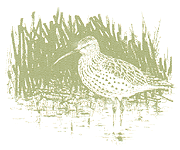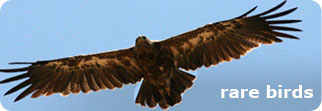 The study or the simple observation of birds is, with no doubt, one of the most interesting activities and many envy ornithologists for this work.
The study or the simple observation of birds is, with no doubt, one of the most interesting activities and many envy ornithologists for this work.
However, when one is called to deal with some species that they are in the brink of extinction, then the work of the ornithologist brings an overwhelming burden, a sad duty in which its, successful or not, completion may be decisive for the survival of the threatened bird.
This is the case for a wader bird, whose tragic fate linked it with our country and our wetlands.
Slender-billed Curlew (Numenius tenuirostris) is a medium-sized wader, one of the 6 curlews of the same genus living in our world. It nests somewhere in NW Siberia, where in the ‘20s very few nests were found.
Thenceforth, no one could ever find even one nest again, even though the species may still breed, even in extremely few numbers.
After the completion of the breeding period, Slender-billed Curlew began a migration route 5-6,500 km long, bringing them, through SE Russia and SE Europe, to N-NW Africa (mainly in Morocco) for the winter, while a smaller population wintered along the Persian Gulf.
At the second half of the 19th century and until 1920, Slender-billed Curlew was an abundant bird, often exceeding in population density its two relative species, Curlew (Numenius arquata) and Whimbrel (Numenius phaeopus).
Thenceforth, for no known reason, its population started to decline rapidly, and during the last 20 years, the decline was so dramatic, that today Slender-billed Curlew is the rarest curlew in the world, with a world population of few hundreds of birds, probably no more than 50-200 birds.
Besides that, Slender-billed Curlew remains a bird whose ecology and biology (food habits, breeding behavior, etc) are unknown. At the same time, it looks very alike Curlew and Whimbrel that even experienced ornithologists find its recognition very difficult.
Rarity, unknown ecology and difficulties in recognition are three decisive parameters that give a hard time to the international scientific community.
Most of Slender-billed Curlew’s observations during the last twenty years come from SE Europe (Hungary, Italy, Ukraine, etc), i.e. countries along its migration route. Until the ‘60s several Slender-billed Curlews wintered in coastal wetlands of Morocco, mainly in Merja Zerga Lagoon where until 1994/5 1-5 birds were regularly visiting the area.
Thenceforth, no Slender-billed Curlew has been recorded in Morocco, discouraging even the most optimistic ornithologists, who lost their hopes. And suddenly, in the winter of 1995, a small flock of about 20 Slender-billed Curlews, appeared in S Italy. It was the largest concentration of these birds, proving that Slender-billed Curlews still breed, somewhere between Siberia and the Mediterranean.
The first record of Slender-billed Curlew in Greece came from Corfu in 1857. Thenceforth, 112 records (although some of them may refer to the same bird or birds) have been noted, a world record number, especially in recent years, as this bird seems to be observed only in Greece and nowhere else in the world. Of course, most of the observations are of 1-5 birds, and it seems that we will never see large flocks, like the one of 150 birds in Evros Delta on 20 October 1978.
Most of the observations come from Evros Delta, Porto Lagos and Axios Delta and almost all from March to April (with a marked peak in mid April) and from September to October), i.e. when the birds visit our country on their migration from and to Siberia. It is documented that Evros Delta is the most important habitat of Slender-billed Curlew worldwide, since only here we have an annual appearance of 1-2 birds.
Greece took the responsibility for the study and protection of the species. This was done with the implementation of a co-funded by the EU triennial program (LIFE) where, with the coordination of the General Secretariat for Forests and the Natural Environment of the Ministry of Agriculture, four institutes of Europe, HOS, Greek Biotope and Wetland Center, etc joined their forces for the study of Slender-billed Curlew and the suggestion of specific measures for its protection and rescuing.
The program was completed very recently. Its results are under process and analysis. Although we recorded very few Slender-billed Curlews (8-10 observations of 1-3 birds), the optimum and manifold cooperation of many scientists from many countries, hunters, local authorities, governmental services, research foundations, etc proves that only with international cooperation of this form, even rare birds like Slender-billed Curlew, may safeguard the privilege of survival, in a world becoming more and more harsh towards creatures that grace it. Besides, there’s always room for hope, as HOS’ members proved, recording 4 Slender-billed Curlews on 7/4/1999, in River Evrotas estuary, in Lakonia.


 The study or the simple observation of birds is, with no doubt, one of the most interesting activities and many envy ornithologists for this work.
The study or the simple observation of birds is, with no doubt, one of the most interesting activities and many envy ornithologists for this work.
